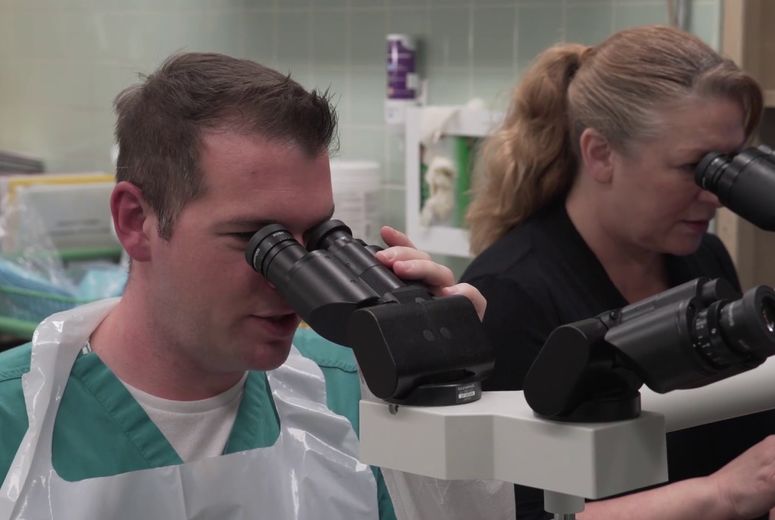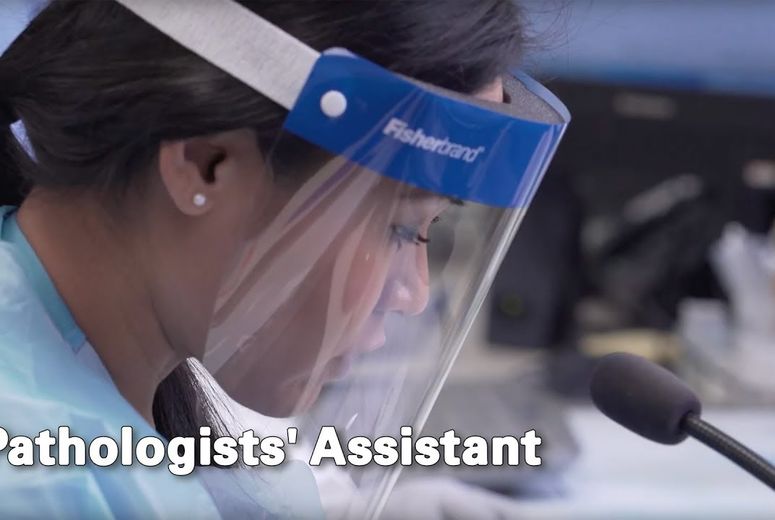A Pathologists’ Assistant Program at Loma Linda University
Loma Linda University affirms the values below as central to its view of education. The Pathologists’ Assistant Program concurs with these values and upholds these values as central to the education of any medical professional.
Applications are open. The annual application period is November 1-March 31.
Core Values
COMPASSION—The sympathetic willingness to be engaged with the needs and sufferings of others. Among the most memorable depictions of compassion in Scripture is the story of the Good Samaritan, which Loma Linda University has taken as a central symbol of our work.
INTEGRITY—The quality of living a unified life in which one's convictions are well-considered and match one's actions. Integrity encompasses honesty, authenticity, and trustworthiness.
EXCELLENCE—The commitment to exceed minimum standards and expectations.
FREEDOM—The competency and privilege to make informed and accountable choices and to respect the freedom of others. God has called us not to slavery but to freedom.
JUSTICE—Guided by Micah 6:8, we strive to act with justice, extend mercy, and walk humbly with God.
PURITY/SELF-CONTROL—The commitment to be morally upright and moderate in all things, with complete control over one's emotions, desires, and actions.
HUMILITY—The willingness to serve others in a sacrificial manner, and the self-respect that renounces haughtiness or arrogance.
What is a Pathologists’ Assistant?
Pathologists’ Assistants (PathAs) are mid-level medical providers (analogous to a Physician’s Assistant) working in the surgical and autopsy divisions of the Pathology Department under the supervision of a medical doctor, usually a Pathologist.
In addition to clinical duties, PathAs are also trained for management of the laboratory, tissue banking, teaching at the college/university level, and research presentation.
In the Surgical Pathology suite, Pathologists' Assistants are responsible for:
- Supervision and management of the “gross” room (requiring knowledge of clinical laboratory management),
- Accurate receipt and assignment of surgical pathology cases (requiring knowledge of Laboratory Information Systems and laboratory accrediting regulations),
- Dissection, description, and submission of tissues from cases (requiring knowledge of anatomy, surgical techniques, medical and pathology terminology, and dissection techniques),
- Ordering of special laboratory and radiologic testing as appropriate for pathology present (requiring the ability to recognize pathologies present in tissue and application of appropriate special testing),
- The ability to perform a frozen section intraoperative procedure
- Biomedical photography of specimens (requiring knowledge of distinct techniques for various specimens),
- Communication with surgeons, pathologists, and ancillary medical staff (requiring excellent interpersonal skills, patience, compassion, and a good knowledge base of management, medicine, and pathology!).
No day is ever the same in the surgical pathology suite, that’s what makes our job exciting and interesting! Our career provides lifelong learning opportunities- just when you think you’ve seen it all, something new and amazing arrives from the operating room. It’s always a challenge!
In the Autopsy suite, Pathologists' Assistants are responsible for:
- Management and maintenance of autopsy suite (requiring knowledge of clinical laboratory management protocols, proper procedures and techniques specific to the autopsy suite, regulations and requirements of the institution, state, and federal agencies and accrediting bodies),
- Ensuring (and sometimes obtaining) the correct permission forms for the autopsy (requiring knowledge of institutional, state, and federal regulations and the ability to communicate with family members who have just experienced a painful loss),
- Confirming patient identity prior to the beginning of the procedure (requiring knowledge of why this important, institutional, state, and federal regulations and accrediting body requirements,
- Comprehensive review and knowledge of the patient’s medical history (requiring knowledge of medical and pathologic terminology, correlations of clinical and pathologic findings, SOAP reporting, and medical information systems)
- Performance of the autopsy procedure from the external examination, evisceration, dissection and description of systems to the submission of appropriate tissues which allow the pathologist to make an accurate final diagnosis (requiring extensive knowledge of anatomy, autopsy techniques, and the ability to recognize normal and abnormal anatomy and pathology).
- Formulation of a preliminary anatomic diagnosis and autopsy report in collaboration with the attending pathologist (requiring the ability to correlate gross findings with knowledge of pathology and disease mechanisms).
Loma Linda University School of Medicine Pathologists' Assistant Program will prepare you for all of this.
The American Association of Pathologists’ Assistants was founded in 1972. The first training program was Duke University in Durham, NC, founded in response to a need for qualified assistants in the pathology laboratory fueled by a continuing shortage of pathology residents. The Pathologists’ Assistant tract continues to emerge as one of the fastest growing specialties in medicine, with opportunities available all over the US, Canada, and Australia.
Loma Linda University Pathologists’ Assistant Program Mission and Goals
The Pathologists’ Assistant program is a full-time, two year Master’s degree. The first year is didactic, with some exposure to the gross room and autopsy suite procedures, and frozen section training. The second year consists of clinical rotations and a comprehensive review course which prepares the student for the national certification examination.
The Mission of the LLU Pathologists’ Assistant Program is to:
- Educate the next generation of well-qualified, competent Allied Health Professionals as Pathologists’ Assistants.
- Instill moral and ethical values in students to apply to their daily of practice of medicine and patient care.
- Prepare graduates to be successful at taking the national certification exam given by the American Society of Clinical Pathology. **
- Assist students in obtaining jobs in hospital laboratories, academic centers, private laboratories and academic centers. ***
Goals of the LLU Pathologists’ Assistant Program:
Following completion of the university-approved curriculum, the student will:
- Appreciate the connection and relevance of the daily work of the Pathologists’ Assistant to the complete picture of diagnosis, treatment, and prognosis of the patient.
- Demonstrate professionalism in the practice of pathology, the teaching of residents and other medical professionals, the management of fellow staff, and interactions with patients and their families.
- Provide accurate and timely dissection and submission of patient specimens to provide the Pathologist with a clear picture and information such that an appropriate final diagnosis can be rendered.
- Perform a complete autopsy from obtaining correct permissions to the operation of the entire autopsy procedure to the formulation of a preliminary anatomic diagnosis to assist in providing families and medical staff with correct information regarding the death of their loved one and patient.
- Recognize basic normal and abnormal microscopic morphologies to assist the Pathologists with conference and research materials and teach at the university level.
- Integrate tissue banking processes into surgical and autopsy pathology practices for research and teaching.
**Successful completion of the Master’s degree program is not contingent upon passing any external certification exam, only of the approved program curriculum and the comprehensive final exam within the program.
***The student is trained and counseled in CV writing, Interviewing and Job Negotiation skills and given guidance by the program and university staff, but employment is not guaranteed- that is the student’s responsibility.
Learning Outcomes:
Outcome 1: Students will be able to demonstrate and perform the appropriate anatomic pathology techniques for the preparation, gross description and dissection of human surgical tissue specimens, to include:
- Accessioning in laboratory information systems.
- Recovering from data archives the relevant patient clinical information and history, including scans, x-rays, laboratory data and correlate with pathologic findings
- Dissection, description, and appropriate submission of gross anatomic features and recognized pathology of surgical specimens.
- Preparing tissues by appropriate fixation for histological processing prior to examination by light, electron and immunofluorescence microscopic examination
- Selecting, preparing and submitting appropriate tissue samples for frozen section analysis as appropriate and performing the frozen section procedure to prepare a diagnostic slide for Pathologist review.
- Obtaining appropriate tissue and body fluid samples for ordering special testing as necessary, based on tissue type and pathology present including but not limited to immunofluorescence, flow cytometry, cytogenetics, and microbiology.
- Awareness of tissue biorepository regulations and protocols, and ability to correctly obtain permissions, collect and store tissue.
- Photographing and/or digitizing gross tissue specimens and microscopic slides of embedded sectioned and stained tissue slides
- Ensuring that all appropriate protocols are followed, that data reports are generated in a timely manner and that there is adherence to all safety requirements
- Knowledge of CPT coding of surgical and autopsy according to AMA and NCCI guidelines.
- Ensuring that equipment is maintained and that supplies of reagents and disposable are adequate
Outcome 2: Students will be able to demonstrate and perform the appropriate autopsy pathology techniques for the recovery, preparation, gross description and dissection of human organs and tissue specimens, to include:
- Verifying that proper legal authorization exists and securing copies of same.
- Obtaining, reviewing, and providing to the Pathologist the patient’s medical record and other pertinent data.
- Conferring with the Pathologist to identify any special autopsy material required such as for cultures or smears or whether special examination techniques/studies will be used such as immunofluorescence, toxicology, viral or electron microscopic studies
- Notifying the physician in charge, the funeral home, and all other appropriate authorities prior to commencing the autopsy; coordinating any requests for special samples of tissues or body fluids
- Performing the postmortem examination including, external examination, in situ organ inspection, evisceration, dissection, description and dictation of findings including organ weights, gross anatomic findings, presence or absence of body fluids etc.
- Selecting, preparing and submitting appropriate tissue samples for frozen section analysis as appropriate
- Selecting, preparing and submitting representative tissue samples for examination by light and electron microscopy
- Gathering and organizing clinical information and data necessary for a preliminary summary of the clinical history and formulation of a preliminary anatomic diagnosis in consultation with the pathologist.
- Preparing the body for release (including a listing of the associated biohazards such as contagious disease, radioactive implants etc.) and releasing the body to the appropriate mortuary or funeral home representative
- Assisting in the organization and coordination of Morbidity and Mortality (M&M) conferences, Anatomic Pathology Conferences, Grand Rounds, Tumor Boards and wherever autopsy findings are relevant to patient care
Outcome 3: Students will demonstrate the ability to effectively communicate verbally and in writing. At the completion of this degree program, the students will:
- Prepare effective oral presentations supported by appropriate literature research
- Generate written communications of all types in a professional manner
- Display interpersonal communication skills providing ability to communicate and manage as a mid-level provider with other health care providers, nursing, technicians and staff to provide optimal patient care.
Outcome 4: Students will demonstrate the ability to administer a pathology laboratory/autopsy service successfully. By the end of this degree program, the student will:
- Compile and arrange laboratory goals in a concise and effective manner.
- Construct and coordinate resources (financial, human, technological, and logistical) for optimal laboratory management.
- Compose appropriate and correct laboratory procedures
- Evaluate the effectiveness of implementation plans and redirect resources as appropriate.
Outcome 5: Students will have a basic understanding of teaching pedagogy and an ability to clinically train other health professionals. By the end of this degree program, the student will:
- Research and develop a professional-level lecture on an assigned subject
- Comprehension of educational methodologies and competence to form educational objectives and assessment methods.
- Recognize different learning styles and correlate appropriate teaching methods.


